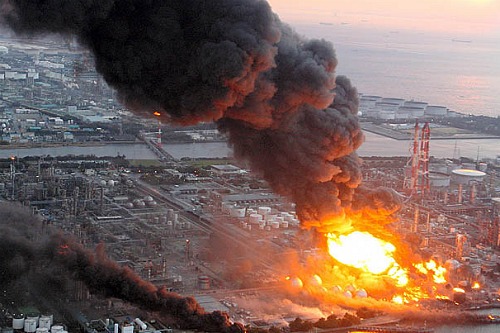일본 지진과 관련된 방사능을 살펴보다
A hot debate over nuclear power has been going on all around the world since the tragic accident in Fukushima. Before the accident, many countries, including the USA, Germany, Switzerland, China and India, had plans to expand their nuclear power plants. Despite the possible danger, we all agree that nuclear technology is one of the strongest candidates for future energy generation in the era of oil-depletion. While countries were competing in expanding the nuclear business, the accident in Fukushima seems to have made many countries think again. Some countries are postponing their plans after the accident in order to systematically manage the safety of the existing nuclear power plants, while others, including US and France, are persistent with the pre-planned expansion. In France, 75% of the electricity comes from nuclear power plants.

Now let's consider the basic physics related to radioactive technology. Radioactive atoms emit three types of particles, , and , which in English means a, b and c as Mari Curie first discovered and coined them. The particle, which is a helium ion, is emitted when the mother nucleus breaks into a lighter nucleus and a helium ion. In certain nuclei, a proton may change into a neutron, emitting an anti-electron, called positron. Or a neutron may change into a proton, emitting an electron. Both the electrons and the positrons are called particles. A nucleus in an excited state may emit a high-energy photon, called ray, and become a nucleus in a lower energy state. In all these decays, there is a loss of mass and that mass is converted into kinetic energy of the daughter nucleus or the decayed particles. Thus the radioactive particles are very energetic passing through the materials in front of them.
Radioactive particles are harmful to the human body since when the high energy particles pass through the body, they tear off electrons from organ cells and destroy the organ's functions. The illness comes either fast or slowly in years depending on the amount of radiation and cannot be cured. Thus the safety of nuclear power plant is essential and they should be stable against earthquakes and fire.
In a nuclear bomb, radioactive atoms are highly concentrated and if the concentration reaches certain critical value, many decays occur in sequences, making chain reactions. In this process large numbers of energetic , and particles are emitted in a very short time period together with a strong windstorm.
Another source of radioactivity is cosmic rays which are high energy particles made from far away stars and which are abundant outside the earth. When they pass through the atmosphere, most of them are scattered and stopped by the atmospheric atoms surrounding the earth. Thus they do not do any damage to living things on the earth. However, when one goes outside the earth’s atmosphere or high above the sky, one is exposed to radioactive particles. One interesting use of the beta particles is PET. In order to find cancers, short-lived radioactive tracer isotopes and sugar are injected into the living subject and the cancer cells actively absorb the sugar together with the radioactive isotopes, which emit positrons. If the positrons meet electrons on the way out, they turn into gamma rays and the PET CT scanner detects the gamma rays to pin-point the place of origin.
In nuclear power plants, the rods of radioactive material are bombarded with neutrons to make the radioactive decay faster. Water is heated in this process which is used to generate electricity. After certain time, the radioactive rods become less effective and should be replaced with new ones. The used rods are still radioactive and dangerous to the human body and they should be put in a deserted place for a long time to become radio-inactive.
In spite of the potential danger of the radioactivity, generating electricity with nuclear power is attractive since the price is at least 5 times lower than the price using petroleum (35KRW/kW vs. 190won/kW). The price of uranium is comparatively cheap as it is abundant. Another merit of nuclear electricity is its very small amount of CO2 gas exhaustion – gas exhaust which will be regulated from 2013. As the oil price is steeply rising and they are expected to be run out sometime in the future, nuclear power becomes rather attractive, even though the leakage of the radioactivity is deadly and costly.
There are many nuclear power plants in Japan and the ones in Fukushima were rather old, older than 40 years. Additionally, they are run by a private company. The plants seemed to survive from the strong earthquake itself. However, the following tsunami brought with it the shortage of electricity needed to circulate water. That malfunction in cooling the nuclear rods brought the dissociation of water into hydrogen and oxygen and, in turn, the hydrogen exploded, scattering the nuclear material into the air. In order to get them under control, people have to get nearer to them, risking the danger of being exposed to the radioactivity. It was touching to see firemen sacrifice themselves to pour water to cool the heated nuclear rods.
Today in Korea, about 30% of electricity is generated by nuclear power. As there is no way of getting cheaper and cleaner energy, and nuclear fusion energy is still in the stage of science fiction, nuclear power seems to be inevitable. Scientists will and should find out better way to maintain safety.
By Lee Kang-seog, Professor, Department of Physics
#308Spotlight
이강석 교수
tribune1968@cnumedia.com

